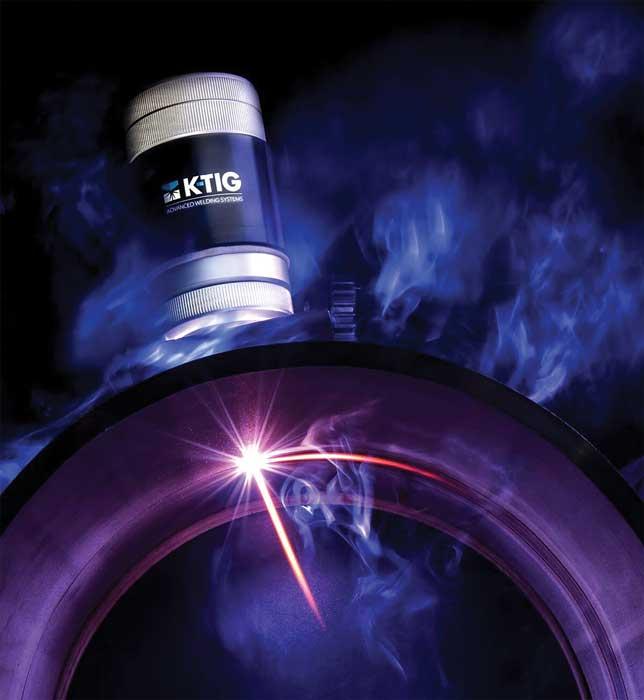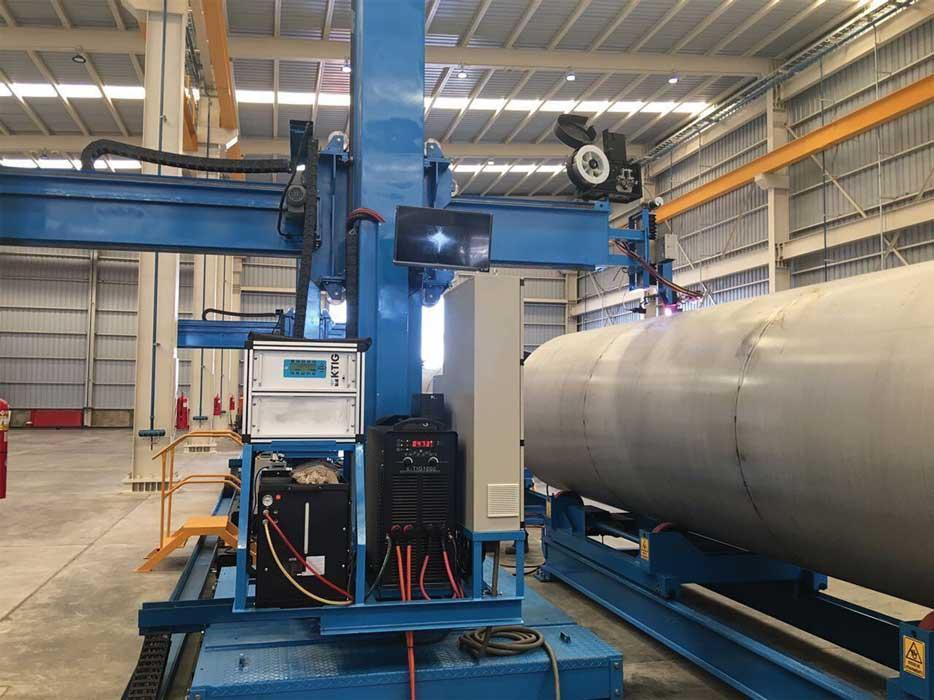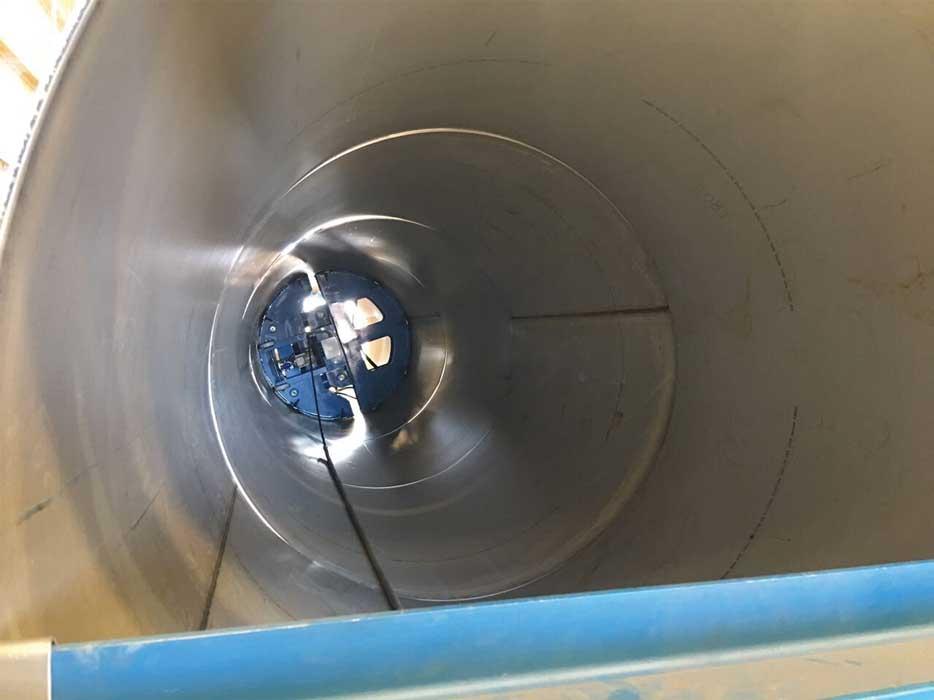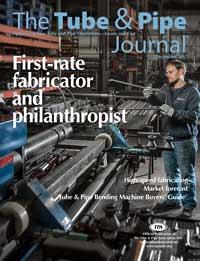- FMA
- The Fabricator
- FABTECH
- Canadian Metalworking
Categories
- Additive Manufacturing
- Aluminum Welding
- Arc Welding
- Assembly and Joining
- Automation and Robotics
- Bending and Forming
- Consumables
- Cutting and Weld Prep
- Electric Vehicles
- En Español
- Finishing
- Hydroforming
- Laser Cutting
- Laser Welding
- Machining
- Manufacturing Software
- Materials Handling
- Metals/Materials
- Oxyfuel Cutting
- Plasma Cutting
- Power Tools
- Punching and Other Holemaking
- Roll Forming
- Safety
- Sawing
- Shearing
- Shop Management
- Testing and Measuring
- Tube and Pipe Fabrication
- Tube and Pipe Production
- Waterjet Cutting
Industry Directory
Webcasts
Podcasts
FAB 40
Advertise
Subscribe
Account Login
Search
Specialized GTAW process a key factor in water purification system project
Pipeline project to provide perpetual, plentiful water supply for parched populace of San Juan
- By Eric Lundin and Tim Heston
- November 20, 2017
- Article
- Arc Welding

The inherent stability of the weld pool and self-correcting nature of the keyhole make the keyhole TIG process more tolerant to gaps, mismatches, and other fit-up imperfections than other keyhole welding processes.
Tucked into a dry valley in western Argentina is a formerly small town on its way to becoming a million-resident metropolis. Home to nearly 700,000 people, San Juan is expected to grow almost 50 percent over the next 50 years. Because the area has a desert climate, receiving less than 8 inches of precipitation annually, the government of Argentina took an interest in providing the community a safe, secure water supply. It oversaw the design and construction of a new pipeline project, the Acueducto Gran San Juan, which will transport drinking water from wells located approximately 15 miles west of the city to complement the existing water system.
The new system will require construction of a water treatment plant known as the Punta Negra plant. Located in the Andes mountains at 4,000 feet above sea level, the Punta Negra plant will be built at the foot of the Punta Negra Dam. The water collected by the plant will be treated by several processes, then transported through the Gran San Juan Aqueduct to Zonda and Gran San Juan, and then through the Ullum Aqueduct to the Marquesado Water Treatment Plant.
Of the 30 miles of pipeline needed for this system, approximately 21 miles will be made from high-density polyethylene. For the remainder, the project calls for stainless steel pipe 63 in. in diameter and 3⁄8 in. thick. This section, known as Acueducto Gran Tulum, represents almost half of the project’s total investment. It is being undertaken by Industrias Metalúrgicas Jaime SRL, a company that has assembled more than 4,600 tons of stainless steel to fabricate the pipeline.
An Unconventional Welding Process Emerges
K-TIG became involved in the Acueducto Gran San Juan at the request of Industrias Metalúrgicas Jaime SRL.
“Before they started the project, Industrias Metalúrgicas Jaime SRL came to me asking for the best welding method available in the market,” said Gustavo Gonzalez, one of the owners of industrial supplier Puertotrans SRL.
“Two years ago, the best welding method we had for this project was submerged arc welding,” he said. “It seemed that this would be the best welding process to use. But, after some research on new welding technology, I found K-TIG.”
Submerged arc welding (SAW) uses a continuously fed consumable electrode. The weld is protected from atmospheric contamination by being submerged under a thick layer of granular flux, which typically comprises lime, silica, manganese oxide, calcium fluoride, and other compounds. As it becomes molten, the flux becomes conductive and provides a current path between the electrode and the material being welded. The flux covering the molten metal helps to reduce sparks and spatter and suppresses the intense ultraviolet radiation and fumes that are generated.
In contrast, keyhole TIG is a high-energy-density variant of gas tungsten arc welding (GTAW), also commonly known as tungsten inert gas (TIG) welding. The process is a high-speed, single-pass, full-penetration welding technology which welds much faster than conventional GTAW. The fundamentals behind the technology were developed by engineers at the Commonwealth Scientific and Industrial Research Organisation, an industrial research division of the Australian government. The chief scientist involved with creating the process acquired the rights for the technology, and those rights were ultimately rolled into K-TIG, a company based in Adelaide, the capital city of South Australia.
The process shares some principles with plasma arc welding (PAW), electron beam welding, and laser beam welding. These high-energy-density joining methods can force a hole—a keyhole—through the material being welded. Molten metal fills in behind the keyhole to form the weld bead, creating a joint in thick material in only one pass. Compared to conventional GTAW, it’s a high-current process, typically using 320 to 600 amps, although the process’s power source has 1,000 amps available at 100 percent duty cycle This enables its use in extreme applications like continuous welding in tube mills.
A chief characteristic is welding speed: in materials up to 5⁄8 in. thick, keyhole TIG typically operates at twice the speed of plasma welding, according to the company.

Figure 1a
Establishing and maintaining a keyhole and controlling the weld pool go hand-in-hand to enable keyhole TIG to tolerate gaps and mismatch. As such, a keyhole TIG system welds in the 1G and 2G positions.
The process works on stainless steel; titanium; nickel alloys like MONEL®, INCONEL®, and HASTELLOY; cobalt alloys; and superalloys. It’s capable of welding square butt joints in stainless steel up to 0.5 in. thick and titanium up to 5⁄8 in. thick. Although the process can work with high-quality, low-sulfur carbon steels, it’s not well suited to low-quality carbon steels.
The amount of mismatch and gap width the process can tolerate varies by application, but on average, mismatch between base metals can be up to 20 percent of the joint thickness, while gaps can be as large as 10 percent of the joint thickness, according to K-TIG. This has to do with the keyhole’s stability. The system produces what Adam Poole, director of sales and commissioning, calls a “self-correcting keyhole,” which makes the process forgiving when it comes to workpiece fit-up. The keyhole cross section looks more like a martini glass than a cylinder. “The keyhole narrows at the root, creating a shape that naturally supports the molten weld pool, Poole said. “This creates a very stable keyhole that is tolerant of imperfections in weld joint fit-up.”
K-TIG’s CEO, Neil Le Quesne, described this phenomenon using a soap bubble analogy. Picture a bubble held in place by two rings above and below. “Move the rings, and the bubble still will maintain its shape, even if the rings are out of alignment,” he said, adding that the moving rings represent changes in joint fit-up. “This happens continuously as you move over gaps and have joint alignment and mismatch issues. Throughout, the integrity of the keyhole isn’t lost.”
Designed to be used in an automated setup, it uses the 1G and 2G positions (see Figure 1A and Figure 1B). The torch is mounted on a slide, with the head of the torch dropping into a supporting carriage. As the height of the material changes during welding, the carriage raises and lowers the torch to maintain consistent voltage.
Peeking through the Keyhole
After receiving an initial email enquiry from Gonzalez, Poole scheduled a call to discuss the scope and scale of the project. After learning more about the material type, thickness, weld length, and the purpose of the pipe, Poole determined that the new process would be a suitable alternative to conventional processes.
At this stage, the company usually produces a productivity assessment that compares keyhole TIG with the conventional process under consideration. The comparison details gas, consumable, and wire consumption and includes other characteristics such as welding speed and penetration. However, because this was a new project, the K-TIG team didn’t have a benchmark process to use as a reference. Instead, it created a detailed weld layout for the entire project and determined the total weld length and the likely preparation and postweld treatments needed for several welding processes. Based on this report, it was evident that the productivity and speed of the new process was unmatched in projected time and cost savings.
In addition to reducing consumable use—keyhole TIG requires no flux and either eliminates or reduces wire consumption, in some cases up to 95 percent—the process eliminates weld preparation and postweld treatments. It also requires no weld preparation and, because it can deliver full-penetration welds on stainless steel up to 1⁄2 in. thick in a single pass, the 3⁄8 in.-thick material of the Acueducto Gran Tulum pipeline posed no problem for the process.
After representatives from Industrias Metalúrgicas Jaime SRL saw several welding demonstrations in the material to be used for the project, the company ordered five systems.
“The productivity of the … process is allowing us to fabricate an average of eight stainless steel tubes per day,” Gonzalez said. The tubes are 40 ft. long by 63 in. dia. by 0.35 in. wall thickness.
“The timeframe in which we had expected to complete the fabrication of all 1,300 tubes was 720 days,” Gonzalez said. “The use of [keyhole TIG] has transformed the economics of the project. We will complete the fabrication in 162 days—an astonishing 550 days ahead of schedule, which is a fantastic result for us, the government, and the people of San Juan.”
Keyhole TIG Ltd. (K-TIG), 9 William St., Bldg. 5., Mile End, Adelaide SA 5031, Australia, 61-8-7324-6800, www.k-tig.com

Figure 1b
Keyhole TIG’s backpurging requirements are similar to those of conventional GTAW. In many applications keyhole TIG requires no special back purging and conventional purging dams are sufficient. Tack welds are simply consumed during the welding process. Sealing passes can be used if an airtight purge is required.
About the Authors

Eric Lundin
2135 Point Blvd
Elgin, IL 60123
815-227-8262
Eric Lundin worked on The Tube & Pipe Journal from 2000 to 2022.

Tim Heston
Senior Editor
2135 Point Blvd
Elgin, IL 60123
815-381-1314
Tim Heston, The Fabricator's senior editor, has covered the metal fabrication industry since 1998, starting his career at the American Welding Society's Welding Journal. Since then he has covered the full range of metal fabrication processes, from stamping, bending, and cutting to grinding and polishing. He joined The Fabricator's staff in October 2007.
About the Publication
Related Companies
subscribe now

The Tube and Pipe Journal became the first magazine dedicated to serving the metal tube and pipe industry in 1990. Today, it remains the only North American publication devoted to this industry, and it has become the most trusted source of information for tube and pipe professionals.
start your free subscription- Stay connected from anywhere

Easily access valuable industry resources now with full access to the digital edition of The Fabricator.

Easily access valuable industry resources now with full access to the digital edition of The Welder.

Easily access valuable industry resources now with full access to the digital edition of The Tube and Pipe Journal.
- Podcasting
- Podcast:
- The Fabricator Podcast
- Published:
- 04/16/2024
- Running Time:
- 63:29
In this episode of The Fabricator Podcast, Caleb Chamberlain, co-founder and CEO of OSH Cut, discusses his company’s...
- Trending Articles
Zekelman Industries to invest $120 million in Arkansas expansion

3D laser tube cutting system available in 3, 4, or 5 kW

Corrosion-inhibiting coating can be peeled off after use

Brushless copper tubing cutter adjusts to ODs up to 2-1/8 in.

HGG Profiling Equipment names area sales manager

- Industry Events
16th Annual Safety Conference
- April 30 - May 1, 2024
- Elgin,
Pipe and Tube Conference
- May 21 - 22, 2024
- Omaha, NE
World-Class Roll Forming Workshop
- June 5 - 6, 2024
- Louisville, KY
Advanced Laser Application Workshop
- June 25 - 27, 2024
- Novi, MI


























